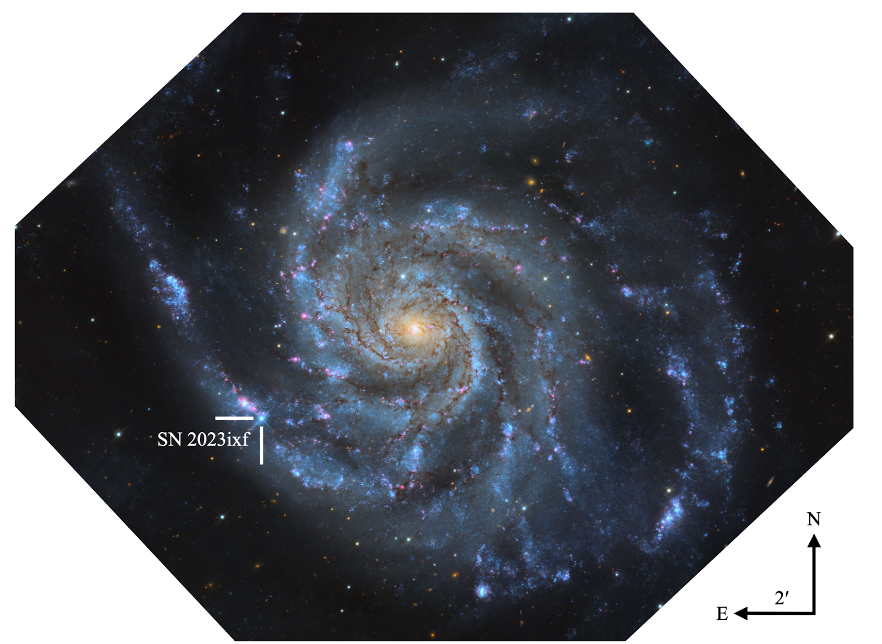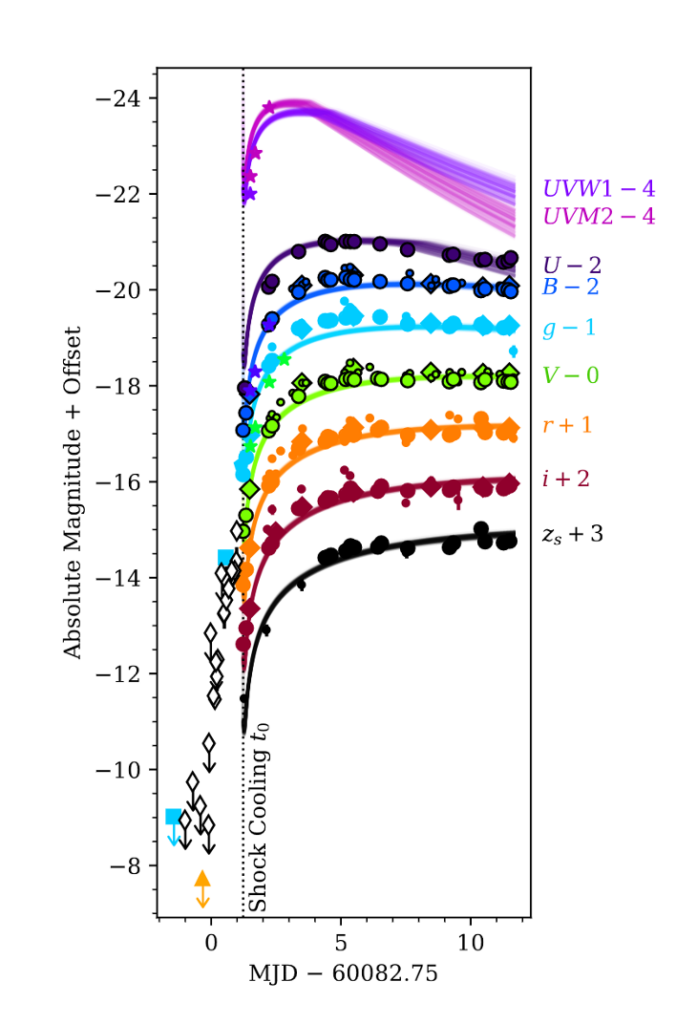Title: Shock Cooling and Possible Precursor Emission in the Early Light Curve of the Type II SN 2023ixf
Authors: Griffin Hosseinzadeh, Joseph Farah, Manisha Shrestha, David J. Sand, Yize Dong, Peter J. Brown, K. Azalee Bostroem, Stefano Valenti, Saurabh W. Jha, Jennifer E. Andrews, Iair Arcavi, Joshua Haislip, Daichi Hiramatsu, Emily Hoang, D. Andrew Howell, Daryl Janzen, Jacob E. Jencson, Vladimir Kouprianov, Michael Lundquist, Curtis McCully, Nicolas E. Meza Retamal, Maryam Modjaz, Megan Newsome, Estefania Padilla Gonzalez, Jeniveve Pearson, Craig Pellegrino, Aravind P. Ravi, Daniel E. Reichart, Nathan Smith, Giacomo Terreran, József Vinkó
First Author’s Institution: Steward Observatory, University of Arizona
Status: [Submitted to] Astrophysical Journal Letters
What happens when a star explodes?
When a high-mass star reaches the end of its life, it dies in a very bright and violent explosion called a core-collapse supernova (CCSN). Check out this amazing bite that talks about simulating core collapse! As a high-mass star evolves through its stages of life, it slowly fuses hydrogen into heavier and heavier elements in its core, moving up the periodic table until it ends up with an iron core. Once the star produces iron, however, it stops fusing into heavier elements. Iron cannot be fused into anything heavier without the addition of any extra energy. Therefore, once there is enough iron in the core of the star, nuclear fusion stops, and the outflow of radiative pressure from the center of the star ceases. This causes the core of the star to collapse under its own gravity, creating the CCSN. All supernovae are incredibly bright. A supernova can emit the total amount of light the Sun emits in one year in a single second ! That’s why we are able to see supernovae out to cosmological distances (100s-1000s of megaparsec). But this also means that if we see a supernova very closeby, we can follow it to very good detail.
There are many kinds of core collapse supernovae (CCSNe), including Type Ib, Ic, and II supernovae. Check out this bite to understand the diversity of supernova explosions! In this bite, we will focus on Type II supernovae, which have spectral signatures of hydrogen. During their lifetimes, massive stars often have strong winds, which carry away much of their outer layers. As such, these stars are often surrounded by thick layers of mass, called circumstellar material (CSM), at the end of their lifetimes. Then, when the star explodes as a supernova, the ejected matter that is launched from the star interacts with the CSM. Whenever a very fast-moving (the ejecta moves at ~1000s km/s!) cloud crashes into another, much slower cloud (the CSM only moves at ~100s km/s), the collision creates a shock. This shock then heats up the CSM, which then slowly cools after the shock moves through (see Figure 1). This cooling, called shock cooling, contributes to the total brightness of Type II supernovae.

For Type II supernovae, the CSM layers are so thick that as the ejecta propagates through these layers of CSM, the light emitted by shock cooling is much brighter than the actual supernova brightness and the light curve is dominated by shock interactions. One such Type II supernova was detected very closeby very recently.
What was SN 2023ixf?
SN 2023ixf was discovered on May 19, 2023 in the Pinwheel Galaxy, which is only 7 megaparsec away (for context, the nearest galaxy to ours, the Andromeda Galaxy, is ~1 Mpc away). Figure 2 shows the location of the supernova in its host galaxy. Soon after discovery, it was classified as a Type II. It was so close that we detected it a couple days earlier than normal, when it was still about 200 times dimmer than its peak luminosity, and giving us excellent early-time coverage of the supernova light curve.

Because this supernova is so close, it will remain bright enough to be observed for much longer and in much more detail than other supernovae. The last supernova that was this close, SN 2011fe, was actually also in the same galaxy!
Because this supernova is so close, it will remain bright enough to be observed for much longer and in much more detail than other supernovae. The last supernova that was this close, SN 2011fe, was actually also in the same galaxy! This paper specifically focuses on the early time observations of this supernova.
What are Early Time Observations?
When observing any astronomical object, you can plot the brightness measured as a function of time, called the light curve. By measuring in different wavelength ranges, one can plot the light curves in different wavelengths of the same object. For any supernova, the light curve starts out dim, increases to a peak, then slowly decreases over time. Figure 3 shows the light curve of SN 2023ixf.

For this particular supernova, however, the authors of this paper were able to measure the light curve at much earlier times than usual. The first day of the early-time light curve had completely different behavior than the rest of the light curve. When the authors fit a shock cooling model to the full light curve, they find a very poor fit. Fitting the model to the light curve without the first day, they find an excellent fit (see Figure 2) with explosion time t0 (the dotted vertical line).
The supernova was actually detected almost an entire day earlier than this time (all the white diamonds to the left of the dotted vertical line)! This means that this light must be coming from something other than shock cooling. It could in fact be light directly from the supernova explosion, rather than the subsequent shock interactions.
What Does This Mean?
The fact that shock cooling itself cannot explain the light curve of this SN 2023ixf opens up the question of whether something else was happening during the first few days of the SN 2023ixf explosion. A potential explanation is that the star itself had an eruption of mass before explosion, which drove up the luminosity before the supernova itself. Another possibility is that there was an exceptionally dense layer of CSM immediately surrounding the star that could have physically slowed the ejecta.
Future Avenues
Such very early observations are extremely rare for Type II supernovae because most are too far away to be visible at such early times. By studying these very early light curves of supernovae, we can better understand how the closest layers of mass surrounding high mass stars are formed. In addition, cases like SN 2023ixf show that more rapid, immediate follow-up of supernovae can shed light on cooler science, like being able to probe the very first hours after a supernova explodes!
Astrobite edited by Huei Sears
Featured image credit: Authors of today’s paper
